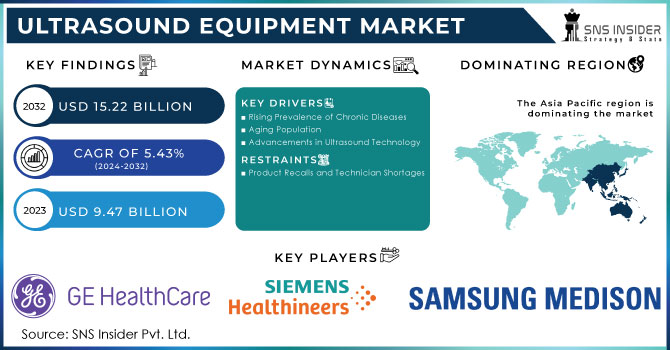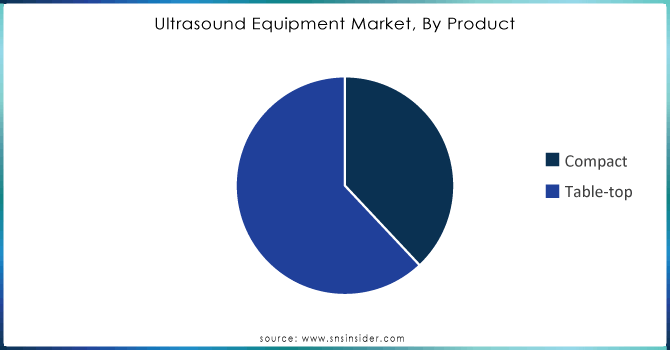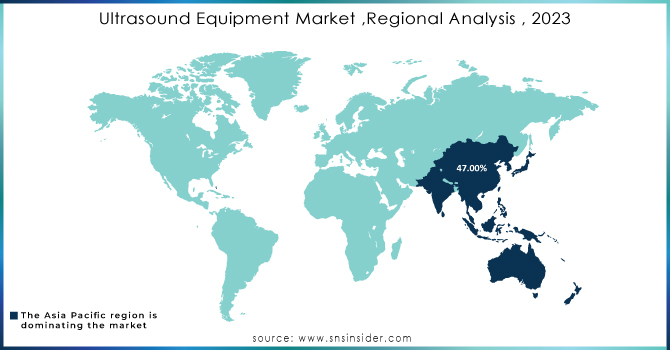Ultrasound Equipment Market Report Scope & Overview:

Get more information on Ultrasound Equipment Market - Request Free Sample Report
The ultrasound equipment market size was valued at USD 9.47 billion in 2023, and is expected to reach USD 15.22 billion by 2032, and grow at a CAGR of 5.43% over the forecast period 2024-2032.
Ultrasound equipment has become an indispensable tool in modern healthcare. Its non-invasive nature, real-time imaging capabilities, and versatility have driven significant demand across various medical specialties.
The ultrasound equipment market is experiencing robust growth driven by the increasing prevalence of chronic diseases, aging populations, and technological advancements. The demand for accurate and efficient diagnostic tools is propelling the adoption of ultrasound systems across healthcare settings.
The rising incidence of cardiovascular diseases, cancer, and other conditions requiring regular monitoring is a key driver of ultrasound equipment demand. Additionally, the growing preference for non-invasive procedures and the expanding application of ultrasound in point-of-care settings are contributing to market growth. According to the World Heart Federation, over half a billion people worldwide are affected by this condition. In 2021 alone, CVDs claimed a staggering 20.5 million lives, representing nearly one-third of global deaths. This marks a dramatic 60% increase compared to 1990, underscoring the urgent need for effective prevention and treatment strategies. With an estimated 20 million new cases and 9.7 million deaths in 2022 alone, cancer remains a leading cause of mortality worldwide. These staggering statistics highlight the critical need for early detection and effective treatment strategies, underscoring the vital role of diagnostic tools like ultrasound equipment in combating this disease.
The ultrasound equipment market is characterized by a competitive landscape with several major players offering a wide range of products. Technological innovation and product differentiation are crucial for gaining a competitive edge.
Governments worldwide are investing in healthcare infrastructure and promoting preventive care, which is driving the demand for medical imaging equipment, including ultrasound systems. Initiatives to improve healthcare access in rural and underserved areas are also creating opportunities for ultrasound equipment providers.
Advancements in ultrasound technology, such as AI integration, 3D/4D imaging, and portable devices, are reshaping the market. The integration of ultrasound with other imaging modalities and the development of specialized ultrasound systems for specific applications are emerging trends. The integration of artificial intelligence (AI) is revolutionizing image analysis, enabling faster and more accurate diagnosis. AI-powered systems can automatically recognize and analyze musculoskeletal abnormalities, improving diagnostic precision and efficiency.
A significant leap in ultrasound technology was achieved in February 2023 with the FDA approval of Clarius Mobile Health's HD3 device. This third-generation ultrasound system incorporates artificial intelligence to rapidly identify and measure tendon structures in the foot, ankle, and knee. By automating these tasks, the technology accelerates injury diagnosis and treatment, demonstrating the potential of AI to revolutionize musculoskeletal imaging.
Moreover, advancements such as high-frequency ultrasound and elastography are enhancing image quality, providing more detailed anatomical information, and enabling quantitative analysis. These technological breakthroughs are expanding the diagnostic capabilities of ultrasound and increasing its clinical utility.
Overall, the ultrasound equipment market is expected to continue its growth trajectory, driven by favorable demographic trends, technological advancements, and increasing healthcare spending.
Market Dynamics
Drivers
-
Rising Prevalence of Chronic Diseases
The increasing incidence of conditions like heart disease, diabetes, and cancer necessitates regular monitoring and diagnosis, which heavily relies on ultrasound imaging.
The prevalence of chronic diseases in the United States is at epidemic levels. Over 129 million Americans grapple with at least one chronic condition, with many managing multiple diseases simultaneously. These conditions, including heart disease, cancer, diabetes and obesity, account for a significant portion of the nation's leading causes of death and disability.
The escalating burden of chronic illness has placed immense pressure on the healthcare system. Approximately 90% of total healthcare expenditures are dedicated to managing chronic diseases, underscoring the urgent need for effective diagnostic tools and monitoring solutions.
-
Aging Population
As the global population ages, the demand for diagnostic imaging, including ultrasound, increases due to the higher prevalence of age-related health issues.
-
Advancements in Ultrasound Technology
Continuous technological innovations are enhancing the capabilities of ultrasound machines, making them more accurate, efficient, and versatile, thereby expanding their applications.
-
Increasing Preference for Non-Invasive Procedures
Ultrasound is a non-invasive imaging technique, making it a preferred choice for patients and healthcare providers.
-
Growth of Point-of-Care Ultrasound
Portable ultrasound devices are gaining popularity for use in various settings, such as emergency departments, critical care units, and outpatient clinics.
Restraints
-
Product Recalls and Technician Shortages
Product recalls initiated by regulatory bodies due to safety concerns or performance issues can damage brand reputation and erode consumer confidence. For instance, Koninklijke Philips N.V.'s recall of the Sparq ultrasound device in 2021 due to battery issues exemplifies this risk.
Furthermore, a shortage of trained technicians, particularly prevalent in regions like Australia, the U.K., and Canada, poses a significant obstacle to market expansion. The inability to find qualified personnel to operate and maintain ultrasound equipment limits the adoption of these systems, impacting overall market growth.
Key Segmentation
By Product
Table-top dominated the market with 62% share in 2023 due to their widespread adoption in hospitals and clinics for a variety of diagnostic imaging procedures. The extensive installation base, as evidenced by over 130,000 table-top units installed globally by ESAOTE SPA alone, underscores this segment's dominance.
However, the compact segment is emerging as the fastest-growing category. Advancements in technology, coupled with the introduction of innovative handheld devices like Mindray Bio-Medical's TE Air and GE Healthcare's Vscan Air, are driving this rapid expansion. The portability, ease of use, and ability to perform point-of-care ultrasounds are key factors propelling the adoption of compact systems.

Get Customized Report as per your Business Requirement - Request For Customized Report
By Application
Radiology emerged as the dominated segment in 2023 with 43% market share. The increasing number of radiology centers and the widespread use of ultrasound for general imaging and diagnosing medical complications have contributed to this segment's leadership. As highlighted by a study from Poland, the high volume of ultrasound examinations in radiology departments underscores the segment's importance.
The gynecology segment is anticipated to experience the fastest growth. The rising prevalence of gynecological disorders, coupled with technological advancements in ultrasound equipment, is driving demand for advanced diagnostic systems in this area.
By End User
Hospitals dominated the market with 72% share in 2023 due to higher patient admissions, well-established infrastructure, and a large volume of ultrasound procedures performed annually. For instance, the U.S. alone reported millions of patient admissions and hundreds of millions of ultrasound scans in a single year.
However, the clinics segment is poised for rapid growth. The increasing adoption of portable and point-of-care ultrasound systems, coupled with rising patient numbers seeking imaging services, is driving this expansion. The convenience and cost-effectiveness of these systems are making them increasingly popular in clinic settings.
Regional Analysis
The Asia Pacific region dominated the ultrasound equipment market with 47% share in 2023, bolstered by high sales volumes and cost-effective manufacturing hubs like China. Companies such as CHISON Medical Technologies have significantly contributed to this growth, with a substantial portion of their revenue derived from overseas markets.
North America, while holding the second-largest market share, is a hub for technological advancements and new product launches. The COVID-19 pandemic accelerated innovation in the region, as evidenced by the introduction of advanced point-of-care ultrasound systems like Mindray Medical's TE7 Max.
Europe is another key market, driven by an aging population grappling with chronic diseases and a well-established healthcare infrastructure. The region's high prevalence of diabetes further fuels the demand for diagnostic imaging tools like ultrasound.

Key Players
The major players are GE Healthcare, Hitachi, Siemens Healthcare, Samsung Medison, Esaote, Canon Medical Systems Corporation, and other players
Recent Developments:
January 2024: GE Healthcare launched its new LOGIQ E10 Series, an advanced ultrasound system featuring artificial intelligence (AI)-driven image analysis to improve diagnostic accuracy and efficiency.
March 2024: Siemens Healthineers introduced the ACUSON Sequoia Crown Edition, which offers enhanced imaging capabilities and integrated cloud services for better data management and collaboration.
June 2024: Canon Medical Systems unveiled its Aplio i-series Prism Edition, designed with cutting-edge elastography and Doppler imaging technologies to provide superior performance in vascular and liver diagnostics.
| Report Attributes | Details |
| Market Size in 2023 | US$ 9.47 Bn |
| Market Size by 2032 | US$ 15.22 Bn |
| CAGR | CAGR of 5.43% From 2024 to 2032 |
| Base Year | 2023 |
| Forecast Period | 2024-2032 |
| Historical Data | 2020-2022 |
| Report Scope & Coverage | Market Size, Segments Analysis, Competitive Landscape, Regional Analysis, DROC & SWOT Analysis, Forecast Outlook |
| Key Segments | • By Product (Compact, Table-Top) • By Application (Radiology, Cardiology, Surgery, Point of Care) • By End User (Hospitals, Clinics) |
| Regional Analysis/Coverage | North America (US, Canada, Mexico), Europe (Eastern Europe [Poland, Romania, Hungary, Turkey, Rest of Eastern Europe] Western Europe] Germany, France, UK, Italy, Spain, Netherlands, Switzerland, Austria, Rest of Western Europe]). Asia Pacific (China, India, Japan, South Korea, Vietnam, Singapore, Australia, Rest of Asia Pacific), Middle East & Africa (Middle East [UAE, Egypt, Saudi Arabia, Qatar, Rest of Middle East], Africa [Nigeria, South Africa, Rest of Africa], Latin America (Brazil, Argentina, Colombia Rest of Latin America) |
| Company Profiles | GE Healthcare, Hitachi, Siemens healthcare, Samsung Medison, Esaote, Canon Medical Systems Corporation |
| Key Drivers |
• Rising Prevalence of Chronic Diseases • Aging Population • Advancements in Ultrasound Technology • Increasing Preference for Non-Invasive Procedures • Growth of Point-of-Care Ultrasound |
| Market Restraints | • Product Recalls and Technician Shortages |

